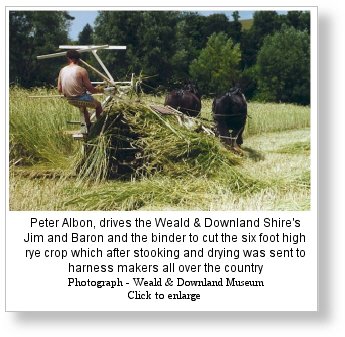
|
|
|
Today very little exceptionally tall rye is grown, but there is still a niche market for it for horse collars. These are in demand for heavy draught horses and light driving horses, and specialist harness makers still produce them. The pad of the collar, which sits next to the horse’s shoulders and takes much of the strain of a horse-drawn load, is stuffed with the long and supple rye straw until hard, and covered with leather or strong cloth. The "Protector" rye grown at the Museum of historic buildings and rural crafts at Singleton, deep in the South Downs, was produced to order for a number of harness makers and for the Countryside Agency, which runs training courses for young harness makers. "Very little rye is grown today," says Museum director, Christopher Zeuner. "We have grown thatching straw for our own use and for commercial thatchers for many years and we were pleased to be able to satisfy the need of British harness makers by harvesting one acre of rye." The crop grew straight and strong, with minimal fertiliser
so as to maintain its strength, and was harvested green, as is
traditional for horse collars. The Museum’s working horses
were used to draw the binder to cut the crop. The straw made
900 sheaves, which were tied by hand and stooked carefully, to
ensure the straw maintained its strength and length. After some
two weeks drying in the field, they will be hauled in ready for
transporting to harness makers. |
|
|
(c) Heavy Horses Online 2007
 Working Shire horses harvested a very unusual crop at the
Weald & Downland Open Air Museum, West Sussex this summer
- rye, grown specifically for harness makers to use in the manufacture
of horse collars.
Working Shire horses harvested a very unusual crop at the
Weald & Downland Open Air Museum, West Sussex this summer
- rye, grown specifically for harness makers to use in the manufacture
of horse collars.